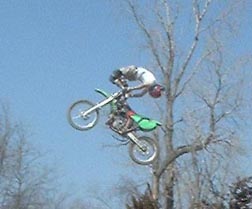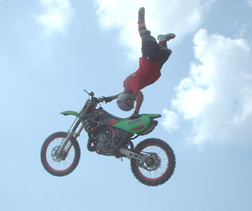First time on a freestyle
motocross ramp?
One of the most common questions in freestyle
motocross riding techniques is "How fast do I go when I hit a
ramp?" and "How do I lean on the bike?". Here
are a few steps to follow when learning to hit fmx ramps.
1) Set
the ramp up at a small distance.
When you get your ramp set up for the first time and are ready to
get riding, start off small. Normally we recommend around 35 feet,
but depending on your skill level you may want to start smaller.
Beginner riders should start maybe around 20 feet,
novice/intermediates at 35-40 feet, and expert or advanced riders
around 45'. Ramps toss riders futher than they normally expect, so
its good to ' work your way up ' .
2)
Practice hitting the ramp in second gear on two strokes.
125's
and 250 two strokes should start in second gear. On a 250 you may be
able to start off in first at gaps smaller than 35 feet, and that
choice is up to you. 250s with stock gearing typically have no
problem going slow and jumping small gaps in second gear, but some
riders may feel more comfortable in first. When the ramp gets to 45
feet and above,
125's should
start clicking third and getting used to the powerband in third
gear. 125's can hit ramps upwards of 60 feet in second gear, but its
good practice to have ramps down with third gear if you are on 125's
in case you encounter ramps 60' and above.
250's are capable of starting in second and staying there. At
extremely small distances, *blurp the
powerband before you get to the ramp and "blurp" it again
as you leave the ramp. This will get you accommodated with the power
band while in second gear. As you work your way back to 45' and
above, the proper throttle technique to use is to roll on the power
as you leave the ramp. Start towards the ramp in the lower rpm range
and accelerate as you approach the jump and keep accelerating as you
leave the ramp/lip. 250's can generally hit ramps up to 80 feet in
second gear.
On
four strokes you
may have to start using third gear before the two strokes need to.
I've noticed that 250 four strokes are geared lower than their 125
two stroke counterparts from 5-10 years ago. When riding a 250f you
may have to click third for gaps bigger than 45 or 50 feet. Maybe
even smaller than that. I don't ride four strokes, so I am not the
best person to be speaking on this topic. All I can do is relay what
I have observed others doing. I would think 450f bikes would still be
fine in second gear for most common ramps and gaps, but again, I'm
not totally sure.
BOTTOM LINE IS
that when you are first starting out on small gaps (20-35
feet), regardless of bike size, two or four stroke, it's a good idea
to feel out second gear and see how well it works. Blurping/hopping
over small gaps in best done in second gear. Again, and
I CAN'T STRESS THIS ENOUGH,
but EVERYONE who is new to riding ramps should start at a small gap
and just feel the ramp out. The only person to know what's best for
you is YOU. Only try what you're comfortable with.
3)Work
the ramp further and further away in small increments.
Start
small and work your way up. If you are a beginner starting at 20
feet, work your way up in 5 feet increments, and familiarize yourself
with each distance before moving on. The same applies for more
advanced riders, but they may be comfortable bumping the ramp back in
6-8 foot increments. From my experience, bumping ramps back more than
8 feet at a time can result in a distance that is a little hard to
judge and you may find yourself casing the jump or severely overjumping.
Getting
a run-up.
On
any ramp at a gap of 35-80 feet, you need to be in second gear (on a
250 two-stroke). Some guys do like third gear, but not serious FMX
riders. Second is much better in the event you accidently cut out
right before the ramp and need to pin it to clear the gap, or for any
other reason need instant access to the 50+ horsepower of a 250cc MX bike.
The
best way to refine your timing is to work on starting with a tight
90 degree corner about 50-65 feet before the ramp (or a little more
if you feel more comfortable) and take the corner barely just
putting. Not like a motocross race. As you go through the corner,
roll on the throttle (and you'll already want to be in second gear)
and set up for the ramp, keep rolling on the throttle, and as your on
the ramp face you'll want to smoothly keep rolling on the throttle to
get as much momentum/speed/acceleration that you need to clear the
gap. You may or may not do this already, but what I have noticed is
that many beginner FMXers have too much run-up and approach the ramp
blurping the throttle and carrying too much speed into the ramp, and
not using the motor to clear the jump. Instead they are using excess
momentum to clear the jump, and that's harder to time.
Click
here for Johnny Jones' tips on hitting a freestyle ramp for the
first time
Body Positioning

Here
the author has just hit the "sweet spot" of the ramp, and
is keeping his legs bent slightly but still stiff, in order to
properly preload the bikes suspension, which will ensure maximum
height and distance.

The
above image depicts the proper body position while leaving an fmx
ramp. The rider is standing with the legs slightly bent, with the
arms bent silghtly. The riders head is up and over the handlebars
looking forward to the landing.

For
the helmet-cam video, click here.
Note:
Listen to the throttle control. The rider kindof "blurps"
the throttle on the way to the ramp, which although normally isn't
good, in his case he was approaching just a little too fast, and
since he wanted to maintain his general speed, he let off just enough
for just long enough to get his speed perfect. Also note that this is
a gap size of 63 feet on an FMXSchool ramp, and the rider is on a CR125.








